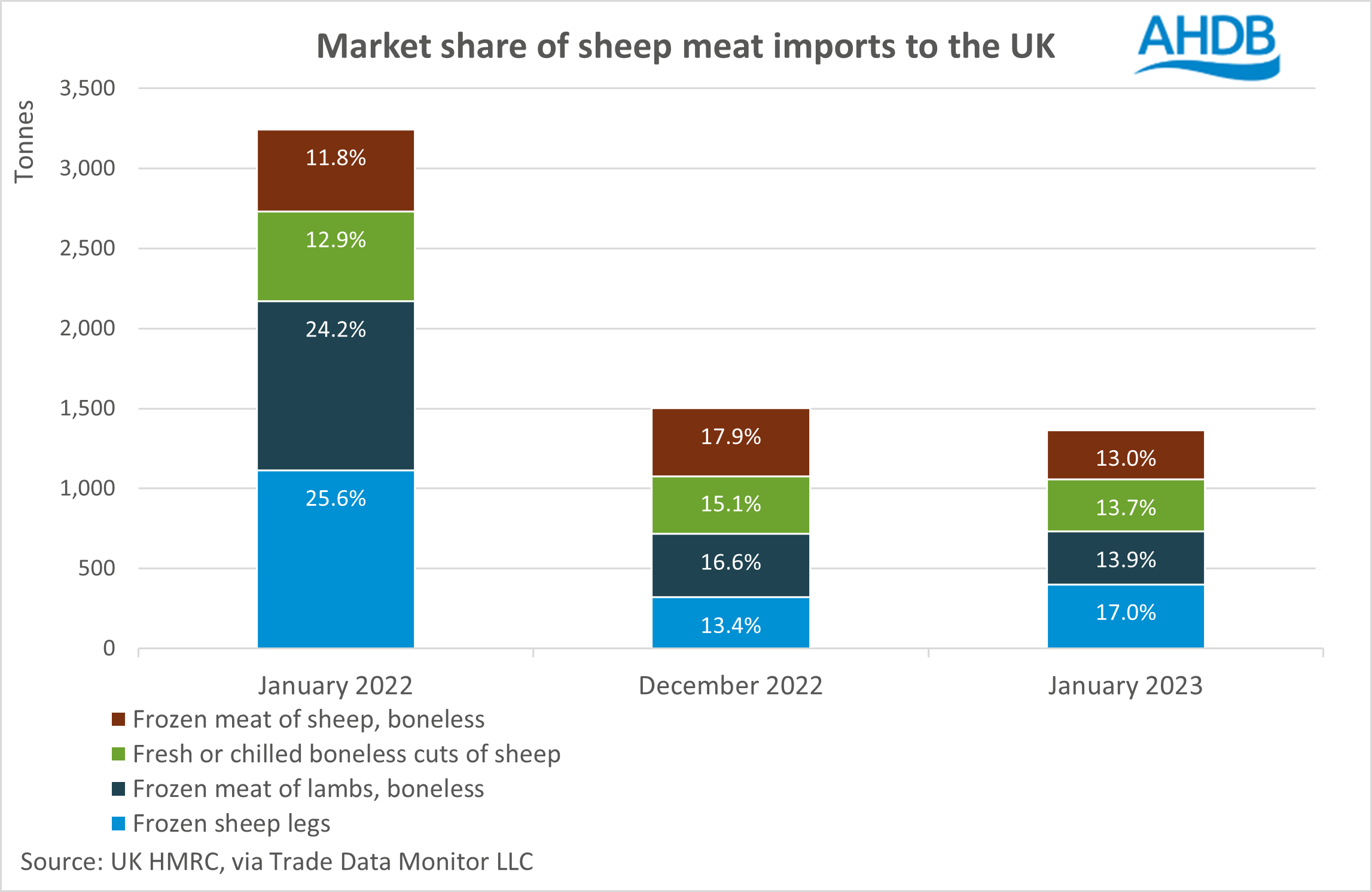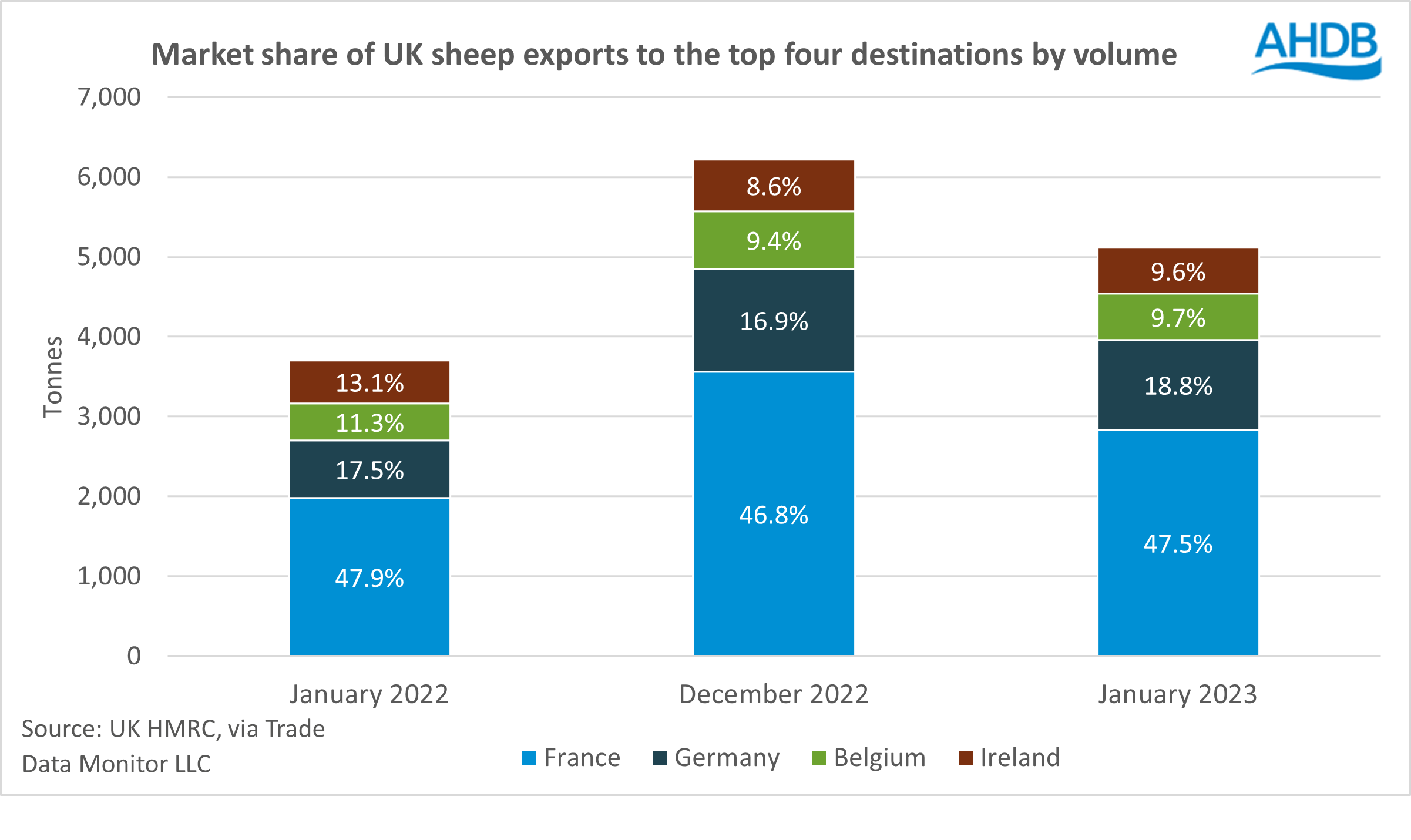Sheep meat imports drop on the year, with exports down on December
Tuesday, 28 March 2023
Imports
Overall levels of sheep meat imports have very marginally fallen to 2,370 tonnes for January, this is a small decline from December’s levels. This marginal change in volumes resulted from a fall of nearly 180 tonnes (20.5%) from Ireland, and an increase of 191 tonnes (30.8%) imported from New Zealand.
Looking to year-on-year volumes, there has been a substantial overall decline of nearly 2,000 tonnes (45.6%) from January 2022. The vast majority of this decline can be attributed to falling imports from New Zealand, down 1,260 tonnes (60.9%) from January 2022. The drop in volume imported from New Zealand was most prevalent in the autumn of 2022, with subsequent lower import volumes remaining relatively equal. Similar trends are seen with Australian imports, down 838 tonnes (55.5%) for the same time period.
Looking at imports from a product perspective, there have been large drops in some categories year-on-year. From January 2022, there has been a decline of 727 tonnes for frozen boneless lamb meat, with a fall of 713 tonnes for frozen sheep legs. Both fresh and frozen sheep meat (excluding lamb) has seen falls of 235 and 204 tonnes on the year too.

Exports
Volumes have fallen on the month but grown on the year as export volumes hit just under 6,000 tonnes for January 2023. There has been a total fall of 1,633 tonnes (21.5%) from December’s levels. Year-on-year however, total export volumes have increased by 44.8% (1,850 tonnes) from 4,130 tonnes in January 2022. Export volumes from January 2022 were still recovering from the previous year’s drop in exports predominantly as a result of regulatory changes, and volumes for January 2023 sit just 500 tonnes shy of the 2016-2020 5-year average.
Exports month-on-month fell to France by 725 tonnes (20.4%), Germany by 169 tonnes (13.1%) and Belgium by 136 tonnes (19%). On the year, exports to France have increased 858 tonnes (43.4%), with an uptick of 400 tonnes to Germany (55.5%), and 115 tonnes to Belgium.
Fresh lamb carcases made up 82% (4,901 tonnes) of total exports in January, with a fall of 1,061 tonnes (18%) exported from December. Other cuts such as fresh short forequarters and chines have seen declines from December, down 163 (47%) and 179 tonnes (55.6%) respectively. However, on the year, lamb carcase exports have risen by 1,370 tonnes (38.8%).

Sign up for regular updates
You can subscribe to receive Beef and Lamb market news straight to your inbox. Simply fill in your contact details on our online form.
While AHDB seeks to ensure that the information contained on this webpage is accurate at the time of publication, no warranty is given in respect of the information and data provided. You are responsible for how you use the information. To the maximum extent permitted by law, AHDB accepts no liability for loss, damage or injury howsoever caused or suffered (including that caused by negligence) directly or indirectly in relation to the information or data provided in this publication.
All intellectual property rights in the information and data on this webpage belong to or are licensed by AHDB. You are authorised to use such information for your internal business purposes only and you must not provide this information to any other third parties, including further publication of the information, or for commercial gain in any way whatsoever without the prior written permission of AHDB for each third party disclosure, publication or commercial arrangement. For more information, please see our Terms of Use and Privacy Notice or contact the Director of Corporate Affairs at info@ahdb.org.uk © Agriculture and Horticulture Development Board. All rights reserved.

